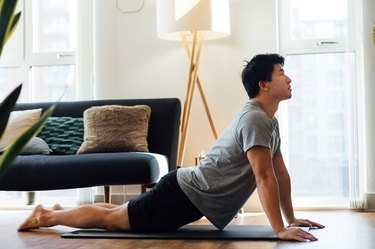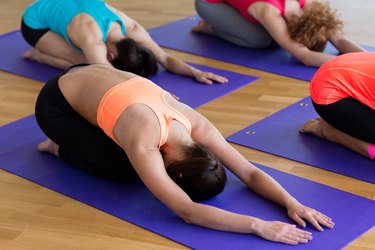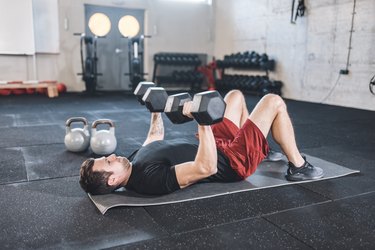
Whether you're just getting back into working out, coming back from an injury or your schedule seems beyond stacked up, you might have only day per week for structured exercise. Not to worry: You can definitely make good use of that time.
In fact, those who did only one or two sessions of weekly exercise, compared to those who did none, had major advantages, including lower risk of early death from cardiovascular disease and cancer, according to a January 2017 study in JAMA Internal Medicine.
Video of the Day
Video of the Day
Also, if you're strategic, you likely don't need to block out hours to try to meet the recommended 150 minutes of weekly activity in one day. Here are some tips for making that single workout into a true health booster.
Easing Back Into Exercise? Do a Dynamic Warm-Up
Sometimes called active stretching or dynamic stretching, these are moves designed to get you prepped for exercise, but they're also effective on their own for maximizing your workout time, says Reda Elmardi, CSCS, a strength and conditioning trainer.
Usually, this warm-up mimics what you're about to do for your main workout. So, if you're going for a run, dynamic stretches would involve powering up your lower-body muscles with a 10-minute set of exercises like lunges, high knees, squats and skater hops, for example. If you're going to be strength training, a dynamic warm-up may be doing body-weight versions of what you have planned, like deadlifts or overhead presses.
A well-rounded warm-up like doing yoga for 15 minutes is also beneficial, adds Elmardi, because it targets multiple muscle groups. No matter what type of warm-up you choose, making this a go-to starting point can increase blood flow and muscle temperature, which contribute to exercise performance, according to a small February 2018 study in the Journal of Exercise Rehabilitation that looked at 13 male college students. Those researchers found that these types of warm-ups can also enhance your mindset and confidence for exercise.
Not sure where to start? Try one of these warm-up routines:
Tight Timeframe? Do HIIT
High-intensity interval training (HIIT) uses short bouts of intense work followed by brief rest periods. That might look like one minute of jumping jacks, then 30 seconds of rest, then one minute of push-ups and so on. Most HIIT sessions are about 15 to 30 minutes, and if you're a beginner it's recommended to start with just 10 to 15 minutes, usually done once per week, making it the perfect one-day-only option.
The most frequently cited barriers to physical activity are lack of time, low motivation and difficulty staying consistent, per a February 2017 meta-analysis in the British Journal of Sports Medicine. Researchers found that HIIT can help address all of these — especially when it comes to busy schedules. Interval training not only gives you a major workout, but it also reduces risk factors associated with blood pressure and blood sugar regulation.
Plus, HIIT is very customizable, Elmardi says. You can put together your own 20-minute session with whole-body moves you enjoy the most, and you can mix low-impact and high-impact or just choose one of those.
Not sure where to start? Try one of these quick HIIT workouts:
Tip
If you're just getting started with HIIT, start slowly, usually with a 15-minute workout that focuses on full-body movements. Pay attention to next-day muscle soreness to make sure you're progressing safely. Also, even though it's only 15 minutes per week, consider putting it on your schedule for the same day and time weekly as a way to stay consistent.
Want Something Low-Impact? Go for a Walk
Another option for making the most of your time is going for a walk, preferably outside if possible, according to Rocky Snyder, CSCS, author of strength-training guide Return to Center.
Going at a swift pace is especially helpful, research suggests. For example, researchers observed brisk walking was linked to an increased life expectancy, as stated in a June 2019 study from the Mayo Clinic Proceedings.
"Walking is truly one of the best activities for the body, with benefits that range from better digestion to improved immunity to stronger heart health," Snyder says. "Also, going outside into fresh air and sunshine is a mental pick-me-up, and it helps you explore where you live, like finding new neighborhoods. That keeps your exercise fresh, which is an important part of staying motivated."
Not sure where to start? Try one of these walking workouts:
- JAMA Internal Medicine: "Association of 'Weekend Warrior' and Other Leisure Time Physical Activity Patterns With Risks for All-Cause, Cardiovascular Disease, and Cancer Mortality"
- American Heart Association: "American Heart Association Recommendations for Physical Activity in Adults and Kids"
- Journal of Exercise Rehabilitation: "The effect of warm-ups with stretching on the isokinetic moments of collegiate men"
- Journal of the American Geriatrics Society: "The association of walking pace and incident heart failure and subtypes among postmenopausal women"
- British Journal of Sports Medicine: "Effects of high-intensity interval training on cardiometabolic health: a systematic review and meta-analysis of intervention studies"








